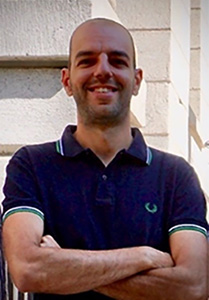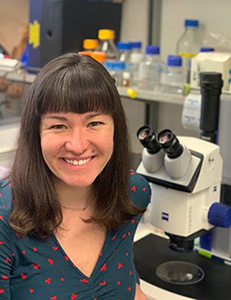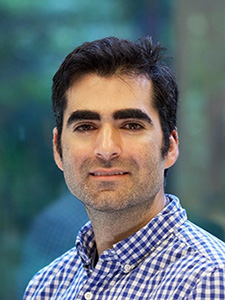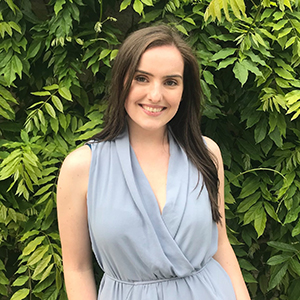Posted on January 14, 2020
 “Dynamic determinants for co-transcriptional gene regulation,” by Dr. Ana Fiszbien, Department of Biology, Massachusetts Institute of Technology.
“Dynamic determinants for co-transcriptional gene regulation,” by Dr. Ana Fiszbien, Department of Biology, Massachusetts Institute of Technology.
The architecture of mammalian genes enables the production of multiple transcripts that greatly expand the coding capacity of our genomes. Impacts of RNA processing on the stability of RNAs are known, but effects on transcription are less understood. I recently described a phenomenon we call exon-mediated activation of transcription starts (EMATS) in which the splicing of internal exons impacts the spectrum of promoters used and expression level of the host gene. I observed that evolutionary gain of new internal exons is associated with gain of nearby promoters. Targeted-inhibition of splicing events reduces the usage of promoters and suppresses gene expression. Conversely, evolutionary creation of a new splice site can activate cryptic promoters nearby. These effects act locally as promoters most impacted by splicing are located proximal and upstream of the splicing event. Our findings support a model in which splicing factors recruit transcription machinery to influence promoter choice and regulate gene expression of thousands of mammalian genes. My future work will focus on the rules governing impacts of promoters and transcription dynamics on RNA processing. I will develop new tools for predicting gene expression from genome sequence and gene architecture that may open up new therapeutic strategies for manipulation of gene expression.
Revised Date: Monday, February 24 at 9:30 am, Michael Smith Laboratories Lecture Theatre, MSL 102
Read More | No Comments
Posted on January 14, 2020
 “Dissecting mechanisms that govern cellular plasticity, ” by Dr. Bruno Di Stefano, MGH Department of Molecular Biology, Harvard Medical School.
“Dissecting mechanisms that govern cellular plasticity, ” by Dr. Bruno Di Stefano, MGH Department of Molecular Biology, Harvard Medical School.
Post-transcriptional mechanisms have the potential to influence complex changes in gene expression, yet their role in regulating stem cell potency and cell fate transitions remain largely unexplored. We have recently identified the RNA processing protein NUDT21 as a key factor that restricts cell identity by modulating the alternative polyadenylation of mRNAs encoding chromatin regulators. In addition, through systematic characterization of primed and naïve human embryonic stem cells, we have uncovered an unexpected sensitivity of naïve pluripotent stem cells to MAPK signal inhibition, which affects their proliferation rate, survival and genome integrity. Finally, we have demonstrated that the RNA helicase DDX6 acts as a key regulator of mammalian cell fate through its control of P-body assembly in both pluripotent stem cells and adult progenitor populations.
Thursday, February 6 at 9:30 am, Michael Smith Laboratories Lecture Theatre, MSL 102
Read More | No Comments
Posted on January 14, 2020
 “Evolved Molecules: Discovery and Directed Evolution of Nature’s Antibiotic Arsenal,” by Dr. Chad W. Johnson, Department of Biological Engineering, Massachusetts Institute of Technology.
“Evolved Molecules: Discovery and Directed Evolution of Nature’s Antibiotic Arsenal,” by Dr. Chad W. Johnson, Department of Biological Engineering, Massachusetts Institute of Technology.
Antibiotics are essential components of modern medicine, but the overuse of broad-spectrum drugs and the emergence of drug-resistant pathogens have led to a looming crisis for global healthcare. Nearly all of our antibiotics are derived from natural compounds produced by microorganisms, and have been honed through millions of years of natural selection. Initial studies of these microbes and the drugs they produced ushered in a ‘golden age’ of antibiotics, but as discoveries dwindled, many believed this natural resource had been exhausted. However, genomic technologies have revealed a wealth of undiscovered antibiotics encoded within bacterial genomes, prompting a return to these microbial chemists for new leads in the fight against resistance.
In the first section of this seminar, I will detail my work developing genomic and metabolomic platforms for antibiotic discovery. Taking cues from proteomics approaches, these platforms use database-dependent search tools to scour mass spectrometry files for antibiotics that were predicted from bacterial genomes. Subsequently, the development of bio- and chemoinformatic methods allowed us to cluster antibiotic structures based on their biosynthesis, leading to the discovery of evolved chemical families with novel bactericidal mechanisms that could bypass resistance.
Following this, I will describe how synthetic biology can be used to rewire selection pressure and direct the evolution of antibiotics in the laboratory. As a postdoctoral fellow at MIT, I used Phage-assisted continuous evolution (PACE) to achieve bioactivity dependent evolution of an antibiotic gene cluster, driving an accumulation of mutations that significantly improved antibiotic production. Looking forward, I will explore how natural and directed chemical evolution can be harnessed to discover or create precision antimicrobial therapeutics that limit resistance.
Monday, February 3, at 9:30 am, Michael Smith Laboratories Lecture Theatre, MSL 102
Read More | No Comments
Posted on January 14, 2020
 “Cryo-EM reveals active site coordination within a multienzyme pre-rRNA processing complex,” by Dr. Monica C. Pillon, Signal Transduction Laboratory, National Institute of Environmental Health Sciences, NIH
“Cryo-EM reveals active site coordination within a multienzyme pre-rRNA processing complex,” by Dr. Monica C. Pillon, Signal Transduction Laboratory, National Institute of Environmental Health Sciences, NIH
Ribosome assembly is a complex process reliant on the coordination of trans-acting enzymes to produce functional ribosomal subunits and secure the translational capacity of the cell. Las1 is a recently discovered endoribonuclease that assembles into a multienzyme complex with the Grc3 polynucleotide kinase to orchestrate RNA decay of a transcribed spacer (ITS2) from precursor ribosomal RNA (pre-rRNA). The essential Las1 endoribonuclease cleaves the ITS2 spacer at a defined site to initiate pre-rRNA processing. The Grc3 polynucleotide kinase subsequently phosphorylates the resulting 5’-hydroxyl RNA to signal for 5’- and 3’-exoribonucleases to degrade the ITS2. Disruption of mammalian Las1-Grc3 has been linked to congenital lethal motor neuron disease and X-linked intellectual disability disorders, thus highlighting its importance in human health; yet, its mechanism of action remains unclear. Here we report that the Las1 endoribonuclease assembles into a higher-order tetrameric complex with its binding partner the Grc3 polynucleotide kinase, which is essential for the activation of its nuclease and kinase functions. To understand how Las1-Grc3 achieves its strict nuclease specificity and coordinates its dual enzymes, we determined a series of high-resolution Las1-Grc3 structures in multiple conformational states. Structural characterization of Las1-Grc3 reveals its molecular architecture harboring a composite nuclease active site flanked by two discrete RNA kinase sites. Coupled with functional studies, we identify molecular features crucial for RNA specificity and two molecular switches that coordinate nuclease and kinase function. Together, our structures and corresponding functional studies establish how Las1-Grc3 couples its enzymatic functions to drive RNA decay during ribosome assembly.
Thursday, January 30 at 9:30 am, Michael Smith Laboratories Lecture Theatre, MSL 102
Read More | No Comments
Posted on January 14, 2020
 “Sexual Interactions Induce Early Death in Nematodes: Strategies and Counterstrategies,” by Dr. Lauren N. Booth, Department of Genetics, Stanford.
“Sexual Interactions Induce Early Death in Nematodes: Strategies and Counterstrategies,” by Dr. Lauren N. Booth, Department of Genetics, Stanford.
Sexual interactions can dramatically influence health, but the molecular mechanism is poorly understood because the sexes are typically kept separate in biomedical research. In C. elegans and its relatives, interactions between the sexes negatively impact health. I have found that sexual interactions impact health through several genetic pathways that additively contribute to a reduction in health and lifespan. Interestingly, sexual interactions impact health via both highly conserved pathways that play a general role in health as well as novel pathways that play a more specific role in regulating health in response to sexual interactions. While sexual interactions shorten lifespan, I have also discovered that these effects can be counteracted via a gamete-to-soma communication pathway that promotes protection of the soma from sexual stress. This protective pathway has evolved more than once in nematodes, suggesting that it may be key for their reproductive success. Together, these findings shed new light on the molecular effects of sexual interactions on health and has revealed novel pathways that regulate health in response to sexual and gamete signals.
Monday, January 27 at 9:30 am, Michael Smith Laboratories Lecture Theatre, MSL 102
Read More | No Comments
Posted on January 14, 2020
 “Insights into reproductive and neural disorders form developmentally quiescent oocytes,” by Dr. Ethan J. Greenblatt, Department of Embryology, Carnegie Institution for Science.
“Insights into reproductive and neural disorders form developmentally quiescent oocytes,” by Dr. Ethan J. Greenblatt, Department of Embryology, Carnegie Institution for Science.
Abstract: Human primordial follicles are capable of surviving a period of developmental arrest lasting for up to 4-5 decades; however, they develop with high levels of aneuploidy, leading to an estimated miscarriage rate of 30-70%, the cause of which is poorly understood. Mature oocytes store large amounts of RNA and are transcriptionally inactive. We found that translation from stable mRNAs declined substantially during oocyte aging, correlating with a dramatically increased incidence in meiotic spindle instability and early embryonic arrest. In addition, we identified Fmr1, the most commonly mutated gene in premature ovarian failure and autism spectrum disorders, as a factor required for oocyte survival, and found that it functions to weakly activate the translation of large autism-associated proteins also essential for prolonged oocyte function. Our data suggest that the reliance of mature oocytes and neuronal synapses on exquisitely fine- tuned translational control makes them uniquely sensitive to aging and genomic lesions.
Monday, January 20, at 9:30, Michael Smith Laboratories Lecture Theatre, MSL 102
Read More | No Comments
Posted on January 13, 2020

“Development of Biochemical Approaches to Study Siglec-Glycan Interactions”, by Mathew Macauley, Assistant Professor, Department of Chemistry, University of Alberta.
Siglecs are a family of carbohydrate (glycan) binding proteins expressed on white blood cells that have immunomodulatory properties. Siglec-glycan interactions help maintain immune homeostasis and dysregulation of Siglec-glycan interactions have recently been implicated in cancer, neurodegeneration, and autoimmunity. The importance of Siglec-glycan interactions in human health and disease has motivated us to develop genetic, biochemical, and chemical approaches to better understand the glycans ligands of Siglecs. I will discuss our ongoing efforts in this area, with a focus on Siglec-3 (CD33) as a susceptibility locus in Alzheimer’s disease.
Monday, January 20, 2020 at 2:30 pm, LSC#3
2350 Health Science Mall
Hosted by Dr. Lawrence McIntosh
Read More | No Comments
Posted on December 19, 2019

‘Tis the season to wish one another joy and love and peace . Happy holidays and a wonderful New Year! Biochemistry and Molecular Biology office will be closed for the holidays, from noon Tuesday, December 24, 2019 and will re-open Thursday, January 2, 2020.
Read More | No Comments
Posted on November 29, 2019
Congratulations to the Undergraduate Biochemistry 3MT winners.
The Biochemistry and Molecular Biology department along with the BPP club hosted our 5th annual undergraduate biochemistry 3-minute thesis (3MT) event on November 20. Students who are currently in biochemistry directed studies (BIOC 448) or biochemistry honours thesis (BIOC 449) were invited to present the concept behind their research projects to an audience of undergraduate students and a panel of faculty judges. 2 people’s choice winners were selected by the audience and one winner was selected by the judging panel.

Ashley Yang., van Petegem Lab
Judging Panel Winner

Laura Meleady, Ciernia Lab
People’s Choice

An Te Chu, Jan Lab
Peoples Choice
Read More | No Comments
Posted on November 27, 2019
 Congratulations Biochemistry graduates!! UBC will be conferring Biochemistry degrees on Friday, November 29th at 9:00 a.m. in the Chan Centre. Fall 2019 schedule
Congratulations Biochemistry graduates!! UBC will be conferring Biochemistry degrees on Friday, November 29th at 9:00 a.m. in the Chan Centre. Fall 2019 schedule
Read More | No Comments
 “Dynamic determinants for co-transcriptional gene regulation,” by Dr. Ana Fiszbien, Department of Biology, Massachusetts Institute of Technology.
“Dynamic determinants for co-transcriptional gene regulation,” by Dr. Ana Fiszbien, Department of Biology, Massachusetts Institute of Technology. “Dissecting mechanisms that govern cellular plasticity, ” by Dr. Bruno Di Stefano, MGH Department of Molecular Biology, Harvard Medical School.
“Dissecting mechanisms that govern cellular plasticity, ” by Dr. Bruno Di Stefano, MGH Department of Molecular Biology, Harvard Medical School. “Evolved Molecules: Discovery and Directed Evolution of Nature’s Antibiotic Arsenal,” by Dr. Chad W. Johnson, Department of Biological Engineering, Massachusetts Institute of Technology.
“Evolved Molecules: Discovery and Directed Evolution of Nature’s Antibiotic Arsenal,” by Dr. Chad W. Johnson, Department of Biological Engineering, Massachusetts Institute of Technology. “Cryo-EM reveals active site coordination within a multienzyme pre-rRNA processing complex,” by Dr. Monica C. Pillon, Signal Transduction Laboratory, National Institute of Environmental Health Sciences, NIH
“Cryo-EM reveals active site coordination within a multienzyme pre-rRNA processing complex,” by Dr. Monica C. Pillon, Signal Transduction Laboratory, National Institute of Environmental Health Sciences, NIH “Sexual Interactions Induce Early Death in Nematodes: Strategies and Counterstrategies,” by Dr. Lauren N. Booth, Department of Genetics, Stanford.
“Sexual Interactions Induce Early Death in Nematodes: Strategies and Counterstrategies,” by Dr. Lauren N. Booth, Department of Genetics, Stanford. “Insights into reproductive and neural disorders form developmentally quiescent oocytes,” by Dr. Ethan J. Greenblatt, Department of Embryology, Carnegie Institution for Science.
“Insights into reproductive and neural disorders form developmentally quiescent oocytes,” by Dr. Ethan J. Greenblatt, Department of Embryology, Carnegie Institution for Science.




 Congratulations Biochemistry graduates!! UBC will be conferring
Congratulations Biochemistry graduates!! UBC will be conferring